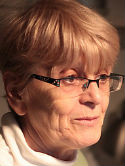Therapy-induced senescence contributes to the efficacy of abemaciclib in patients with dedifferentiated liposarcoma Journal Article
| Authors: | Gleason, C. E.; Dickson, M. A.; Klein, M. E.; Antonescu, C. R.; Gularte-Mérida, R.; Benitez, M.; Delgado, J. I.; Kataru, R. P.; Tan, M. W. Y.; Bradic, M.; Adamson, T. E.; Seier, K.; Richards, A. L.; Palafox, M.; Chan, E.; D'Angelo, S. P.; Gounder, M. M.; Keohan, M. L.; Kelly, C. M.; Chi, P.; Movva, S.; Landa, J.; Crago, A. M.; Donoghue, M. T. A.; Qin, L. X.; Serra, V.; Turkekul, M.; Barlas, A.; Firester, D. M.; Manova-Todorova, K.; Mehrara, B. J.; Kovatcheva, M.; Tan, N. S.; Singer, S.; Tap, W. D.; Koff, A. |
| Article Title: | Therapy-induced senescence contributes to the efficacy of abemaciclib in patients with dedifferentiated liposarcoma |
| Abstract: | Purpose: We conducted research on CDK4/6 inhibitors (CDK4/6i) simultaneously in the preclinical and clinical spaces to gain a deeper understanding of how senescence influences tumor growth in humans. Patients and Methods: We coordinated a first-in-kind phase II clinical trial of the CDK4/6i abemaciclib for patients with progressive dedifferentiated liposarcoma (DDLS) with cellular studies interrogating the molecular basis of geroconversion. Results: Thirty patients with progressing DDLS enrolled and were treated with 200 mg of abemaciclib twice daily. The median progression-free survival was 33 weeks at the time of the data lock, with 23 of 30 progression-free at 12 weeks (76.7%, two-sided 95% CI, 57.7%-90.1%). No new safety signals were identified. Concurrent preclinical work in liposarcoma cell lines identified ANGPTL4 as a necessary late regulator of geroconversion, the pathway from reversible cell-cycle exit to a stably arrested inflammationprovoking senescent cell. Using this insight, we were able to identify patients in which abemaciclib induced tumor cell senescence. Senescence correlated with increased leukocyte infiltration, primarily CD4-positive cells, within a month of therapy. However, those individuals with both senescence and increased TILs were also more likely to acquire resistance later in therapy. These suggest that combining senolytics with abemaciclib in a subset of patients may improve the duration of response. Conclusions: Abemaciclib was well tolerated and showed promising activity inDDLS. The discovery ofANGPTL4 as a late regulator of geroconversion helped to define how CDK4/6i-induced cellular senescence modulates the immune tumor microenvironment and contributes to both positive and negative clinical outcomes. © 2023 The Authors. |
| Keywords: | immunohistochemistry; controlled study; human cell; phenotype; phase 2 clinical trial; gene amplification; pathology; real time polymerase chain reaction; dna microarray; doxycycline; transcriptome; cell aging; benzimidazole derivative; benzimidazoles; liposarcoma; cyclin dependent kinase 4; cyclin-dependent kinase 4; tumor microenvironment; rna isolation; principal component analysis; gene ontology; cellular senescence; dedifferentiated liposarcoma; humans; human; article; palbociclib; rna sequencing; abemaciclib; aminopyridines; aminopyridine derivative; gene set enrichment analysis; a-549 cell line; huh-7 cell line |
| Journal Title: | Clinical Cancer Research |
| Volume: | 30 |
| Issue: | 4 |
| ISSN: | 1078-0432 |
| Publisher: | American Association for Cancer Research |
| Date Published: | 2024-02-15 |
| Start Page: | 703 |
| End Page: | 718 |
| Language: | English |
| DOI: | 10.1158/1078-0432.Ccr-23-2378 |
| PUBMED: | 37695642 |
| PROVIDER: | scopus |
| PMCID: | PMC10870201 |
| DOI/URL: | |
| Notes: | Article -- MSK Cancer Center Support Grant (P30 CA008748) acknowledged in PubMed and PDF -- MSK corresponding authors are Andrew Koff and William Tap -- Source: Scopus |
Altmetric
Citation Impact
BMJ Impact Analytics
MSK Authors
-
 110
110Koff -
 908
908Antonescu -
 477
477Mehrara -
 177
177Chi -
 37
37Landa -
 194
194Qin -
 127
127Keohan -
 232
232Gounder -
 257
257D'Angelo -
 106
106Crago -
 339
339Singer -
 36
36Barlas -
 173
173Dickson -
 161
161Manova-Todorova -
 383
383Tap -
 19
19Turkekul -
 10
10Klein -
 66
66Kataru -
 93
93Kelly -
 109
109Seier -
 99
99Donoghue -
 36
36Richards -
 49
49Movva -
 11
11Adamson -
 20
20Bradic -
 14
14Chan -
 2
2Benitez -
 1
1Gleason -
 1
1Delgado
Related MSK Work





